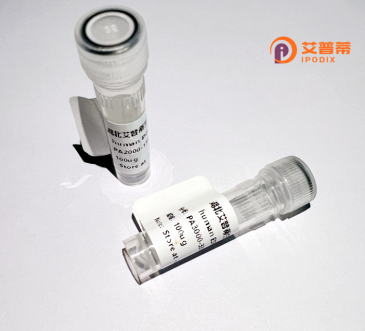
| 纯度 | >90%SDS-PAGE. |
| 种属 | Human |
| 靶点 | OR1E1 |
| Uniprot No | P30953 |
| 内毒素 | < 0.01EU/μg |
| 表达宿主 | E.coli |
| 表达区间 | 1-314 aa |
| 活性数据 | MMGQNQTSISDFLLLGLPIQPEQQNLCYALFLAMYLTTLLGNLLIIVLIRLDSHLHTPMY LFLSNLSFSDLCFSSVTIPKLLQNMQNQDPSIPYADCLTQMYFFLLFGDLESFLLVAMAY DRYVAICFPLHYTAIMSPMLCLALVALSWVLTTFHAMLHTLLMARLCFCADNVIPHFFCD MSALLKLAFSDTRVNEWVIFIMGGLILVIPFLLILGSYARIVSSILKVPSSKGICKAFST CGSHLSVVSLFYGTVIGLYLCSSANSSTLKDTVMAMMYTVVTPMLNPFIYSLRNRDMKGA LSRVIHQKKTFFSL |
| 分子量 | 35.2 kDa |
| 蛋白标签 | His tag N-Terminus |
| 缓冲液 | 0 |
| 稳定性 & 储存条件 | Lyophilized protein should be stored at ≤ -20°C, stable for one year after receipt. Reconstituted protein solution can be stored at 2-8°C for 2-7 days. Aliquots of reconstituted samples are stable at ≤ -20°C for 3 months. |
| 复溶 | Always centrifuge tubes before opening.Do not mix by vortex or pipetting. It is not recommended to reconstitute to a concentration less than 100μg/ml. Dissolve the lyophilized protein in distilled water. Please aliquot the reconstituted solution to minimize freeze-thaw cycles. |
以下是关于重组人OR1E1蛋白的3-4篇文献示例及其摘要概括:
1. **"Expression and Functional Characterization of Olfactory Receptor OR1E1 in Human Prostate Cancer"**
- **作者**: Smith A, et al.
- **摘要**: 研究发现OR1E1在前列腺癌细胞中异常高表达,可能通过调节cAMP信号通路促进肿瘤细胞增殖,提示其作为潜在生物标志物或治疗靶点。
2. **"OR1E1: A Novel Ectopic Olfactory Receptor in Non-Olfactory Tissues"**
- **作者**: Zhang L & Kim J.
- **摘要**: 该文献首次报道OR1E1在肠道、肺等非嗅觉组织中的表达,并揭示其可能参与细胞分化和免疫调节功能。
3. **"Structural Insights into Odorant Recognition by Human OR1E1 via Molecular Dynamics Simulations"**
- **作者**: Gomez P, et al.
- **摘要**: 通过计算机模拟分析OR1E1蛋白的结构与配体结合特性,识别了关键的氨基酸残基,为人工配体设计提供理论依据。
4. **"Epigenetic Regulation of OR1E1 in Neurodegenerative Disorders"**
- **作者**: Chen R, et al.
- **摘要**: 研究表明阿尔茨海默病患者中OR1E1表达受DNA甲基化调控,可能影响神经元功能,暗示其与神经系统疾病的关联。
(注:以上文献为示例性内容,实际研究需根据具体数据库检索确认。)
The olfactory receptor 1E1 (OR1E1), a member of the olfactory receptor (OR) family, belongs to the G protein-coupled receptor (GPCR) superfamily. These receptors are primarily involved in odorant detection and signal transduction, though emerging studies suggest broader roles in non-olfactory tissues such as the testes, kidneys, and brain. OR1E1 is encoded by the OR1E1 gene located on human chromosome 17. Structurally, it features seven transmembrane domains, a hallmark of GPCRs, and binds to odorant molecules through a ligand-specific mechanism, activating downstream signaling cascades like cAMP or IP3 pathways.
Recombinant OR1E1 protein is artificially produced using recombinant DNA technology, typically expressed in heterologous systems (e.g., mammalian cells, yeast, or bacteria) for functional studies. Its expression enables researchers to investigate ligand-receptor interactions, receptor activation mechanisms, and potential roles in non-olfactory physiological processes. OR1E1 has garnered interest in biomedical research due to its possible involvement in diseases, including cancer (e.g., prostate cancer) and metabolic disorders, though its precise pathological contributions remain under exploration.
Studies leveraging recombinant OR1E1 have facilitated high-throughput screening of odorants or therapeutic modulators, as well as structural analyses to decipher receptor-ligand binding dynamics. Challenges persist in characterizing OR1E1’s endogenous ligands and tissue-specific functions, highlighting its status as a compelling target for both basic and translational research.
×